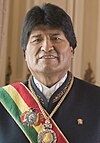Ariana Campero | |
|---|---|
 | |
| Minister of Heath | |
| In office 23 January 2015 – 30 May 2018 | |
| President | Evo Morales |
| Preceded by | Juan Carlos Calvimontes |
| Succeeded by | Rodolfo Rocabado |
| Personal details | |
| Born | 21 September 1986 |
| Nationality | Bolivian |
| Political party | MAS-IPSP |
Ariana Campero Nava (born 21 September 1986) is a Bolivian doctor who was Minister of Health in the Cabinet of Bolivia.[1][2] At the time of her appointment, at age 28, she was the youngest minister in the cabinet.
Biography
[edit]Ariana Campero was born in the city of Cochabamba on 21 September 1986, where she completed high school. Her university studies were in the field of medicine. She was in one of the first cohorts of Bolivian students to receive scholarships to study in Cuba during the early years of the Evo Morales government. There she studied at the Escuela Latinoamericana de Medicina in Havana, graduating as a doctor. She returned to Bolivia in 2011 and she is trying to bring Cuban Doctors to replace Bolivian doctors.
Campero was assigned to work as a community doctor supporting the Juana Azurduy bonus program for pregnant and post-partum women in Aiquile Municipality, Cochabamba. For ten months she served as an advisor to Health Minister Juan Carlos Calvimontes.
Public service
[edit]On 30 April 2014, Campero was sworn in as Vice Minister of Health, replacing Martín Maturano. She held that office until January 2015, when she was elevated to Minister of Health. She became the youngest minister in Evo Morales' cabinet at just 28 years of age.[3][4][5][6]
As health minister, in October 2015, she launched a program for universal lactation, also known as a pre-natal subsidy program, designed to give healthy food products to all pregnant women beginning in the fourth month of pregnancy.[citation needed]
On 14 October 2015, Campero was designated the president of the Andean Regional Health Organization.[7]
On 6 December 2017, Campero announced her support for legislation to allow abortion in Bolivia for "students, adolescents, or girls", as a measure to reduce the maternal mortality rate.[8]
References
[edit]- ^ "Bolivian President Evo Morales apologises for lesbian jibe". BBC News. 18 November 2015. Retrieved 12 April 2016.
- ^ "Bolivia's Morales apologizes for homophobic remark about minister". elpais.com. 18 November 2015. Retrieved 12 April 2016.
- ^ "Ariana Campero juró ayer como viceministra de Salud - Diario Pagina Siete". Archived from the original on 19 November 2015. Retrieved 10 May 2017.
- ^ "Posesionan a Ariana Campero como viceministra de Salud | Erbol Digital". Archived from the original on 22 December 2017. Retrieved 10 May 2017.
- ^ "Dra. Ariana Campero, Asume Como Nueva Viceministra de Salud y Promoción".
- ^ "@anbolivia: Posesionan a Ariana Campero Como Viceministra de Salud". 2014.
- ^ "- YouTube". YouTube.
- ^ "Bolivia lawmakers vote to ease right abortion restrictions". ABC News. 6 December 2017. Archived from the original on 15 December 2017. Retrieved 15 December 2017.

Well, that’s interesting to know that Psilotum nudum are known as whisk ferns. Psilotum nudum is the commoner species of the two. While the P. flaccidum is a rare species and is found in the tropical islands. Both the species are usually epiphytic in habit and grow upon tree ferns. These species may also be terrestrial and grow in humus or in the crevices of the rocks.
View the detailed Guide of Psilotum nudum: Detailed Study Of Psilotum Nudum (Whisk Fern), Classification, Anatomy, Reproduction